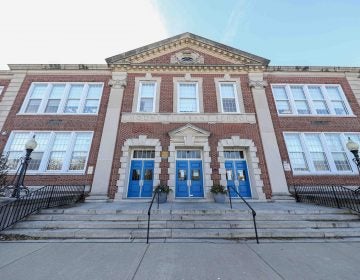Wilmington schools would increase cooperation under Gov. Carney proposal
Gov. Carney’s plan calls for schools in Wilmington, which are now divided among three districts, to work together on curriculum and other things.

File photo: The Bancroft School in Wilmington. (Cris Barrish/WHYY)
Gov. John Carney has been on a tour of Wilmington schools over the past month. He’s met with parents, teachers, and school boards to present the state’s latest effort to improve outcomes for students in the city.
“The children in our city aren’t making the grade right now. We need to do something different,” Carney said.
He said there’s an urgency to get something done now as he enters the second year of his second term. “The children that were going into first grade when I was first elected are in fifth grade now.”
His plan calls for the city’s elementary and middle schools, which are split among three different school districts, to work together in what he’s calling the Wilmington Learning Collaborative.
“It’s fundamentally about helping our children in the city learn to do better and meet the standards, the high standards that we’ve set for them,” Carney said during a presentation for the Red Clay School District board.
The standards not being met at many city schools include reading proficiently at grade three and doing math proficiently in middle school.
For example, just 15% of students at Wilmington’s Warner Elementary scored a grade of proficient in English on last school year’s state tests. Statewide, 41% were proficient in English.
Because city schools are divided among districts, kids who move to another neighborhood in the city could find themselves at a new school with an entirely different curriculum.
While much of the plan’s details are still to be worked out, it includes a common curriculum for all Wilmington schools, as well as longer school days and extended school year. Health centers and counseling services would also be expanded.
The WLC proposal was based in large part on a similar cooperative implemented in Springfield, Massachusetts. State education leaders visited Springfield to see the plan in action.
“We interviewed teachers, staff. We saw what was happening in classrooms and we just thought it was a model that could be effective here for the children of our city,” said Jim Simmons, Chief Equity Officer at the Delaware Department of Education.
Simmons said because more than 80% of some Wilmington districts’ schools are outside the city, district leaders are sometimes more focused on those suburban schools. Forming a cooperative group to help manage city schools could refocus attention where it’s needed.
“This is not a takeover model. This is a collaboration and a partnership,” Simmons said. “We’re asking you to volunteer to be a coalition of the willing, to participate with us in a collaboration to improve outcomes for schools and students in the city of Wilmington.”
Some school board members have questioned the plan and sought more detail on how it would work.
Red Clay board member Kecia Nesmith said what the schools really need is increased support for mental health for students at city schools.
“A lot of the [teacher] turnover has to do with burnout and trauma from daily interactions with students who are experiencing trauma and poverty,” Nesmith said. “If we’re going to do something innovative and creative to ensure the success of all students, then we must almost double that staff in order to make sure that this status quo is changed.”
Another board member, Adriana Bohm, questioned who would make decisions on what’s being taught across the districts’ schools.
“What is the curriculum? Who chooses it? Who teaches it? And what type of qualifications, expertise and knowledge of the community would people need to possess in order to teach that curriculum?” she said.
Carney said those decisions would be made locally by the districts or covered in a memorandum of understanding the participating districts would need to approve to from the cooperative.
The state would pay for new curriculum and professional development to go along with the new materials. Other additional staffing costs could also be picked up by the state depending on the agreement details.
Carney’s plan is just the latest effort to address inequities and poor performance in Wilmington schools.
In late 2015, just before the start of Carney’s first term, the Wilmington Education Improvement Commission approved a plan that would have removed the Christina School District from the city. That plan would have transferred about 2,500 city kids from Christina to Red Clay.
That plan was rejected by state lawmakers in 2016.
Earlier this year, the Redding Consortium for Education Equity offered interim recommendations for reducing inequities and improving outcomes in Delaware’s schools. That group was formed in 2019 to restart what WEIC was unable to accomplish.
Simmons said the effort to get the Wilmington districts to cooperate on curriculum and other things won’t supersede the consortium’s work.
“We hope that whatever decision comes from the Reading Consortium, it will align and this will help them so that it’s a smooth transition to whatever decision comes out of Redding,” he said.
Next month, school boards will be asked to approve moving forward with negotiating an MOU agreement to get the process started. Carney hopes those negotiations can be finished and an MOU approved by March. His goal is for the cooperative work to begin in July.

Saturdays just got more interesting.
WHYY is your source for fact-based, in-depth journalism and information. As a nonprofit organization, we rely on financial support from readers like you. Please give today.







